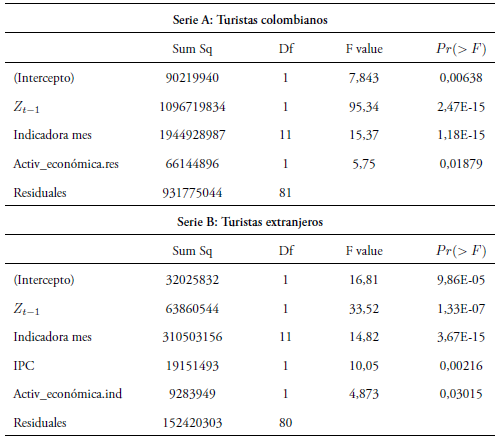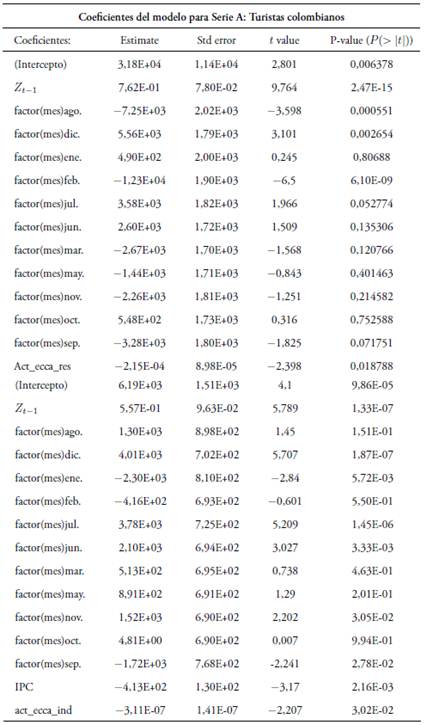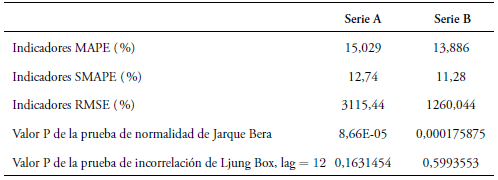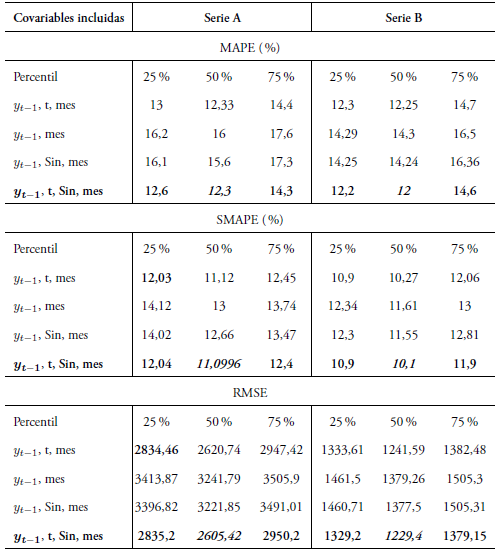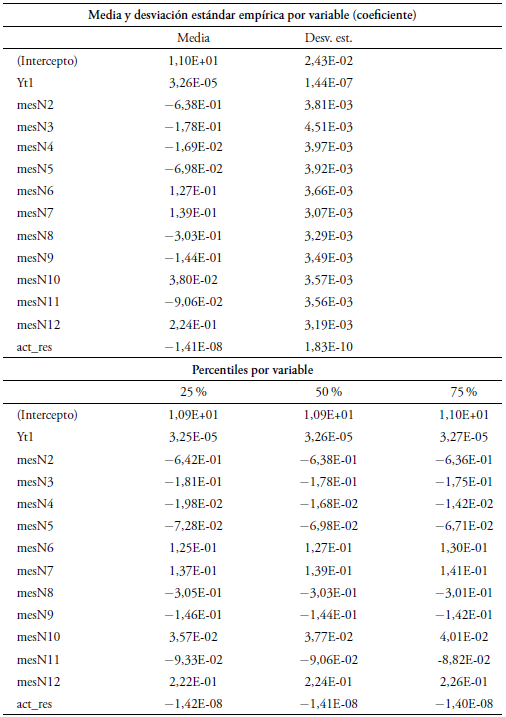Comparación de pronósticos para la dinámica del turismo en Medellín, Colombia
DOI:
https://doi.org/10.17533/udea.le.n86a08Palabras clave:
demanda turística, evaluación de modelos y selección, métodos de pronóstico y predicción, estadística bayesiana, Medellín.Resumen
El turismo es un tema de interés para muchos países, pero en Colombia ha sido poco explorado. Conocer sobre periodos con mayor afluencia de turistas es importante para predecir la cobertura en servicios turísticos. En este trabajo se compara la estimación entre modelos de regresión clásica y bayesianos para elegir la mejor alternativa de predicción de la cantidad de turistas que arribarían a la ciudad de Medellín. Se busca también determinar las variables que más inciden sobre la llegada de turistas y los modelos que permiten ajustar mejor sus dinámicas. Dentro de los resultados obtenidos se observa mejor desempeño de los modelos bayesianos versus los clásicos. Además, la variable mes es significativa para explicar las demandas por parte de turistas colombianos y extranjeros. Los periodos de mayor afluencia de turistas se presentan entre diciembre-enero y junio-julio, comportamiento que se repite anualmente, lo cual es decisivo para la planeación de recursos hoteleros.
Descargas
Citas
Agencia EFE (18 de septiempre de 2014). Informalidad del turismo en Colombia impide su crecimiento, según expertos. El Heraldo. Recuperado de: http://www.elheraldo.co/turismo/informalidad-del-turismo-encolombia-impide-su-crecimiento-segun-expertos-167437
Bes, Christian & Sethi, Suresh (1988). “Concepts of forecast and decision horizons: Applications to dynamic stochastic optimization problems”, Mathematics of Operations Research, Vol. 13, No. 2, pp. 295-310.
Bonilla, Jorge Mauricio & Moreno, María Margarita (2010). Determinantes de la demanda de turismo en Colombia 2004-2007: seguridad, comercio y otros factores. Tesis de Pregrado para optar al título de Economista, Facultad de Economía, Universidad del Rosario, Colombia.
Bowerman, Bruce L.; Oconnell, Richard T. & Koheler, Anne B. (2007). Pronósticos, series de tiempo y regresión: un enfoque aplicado. México: Cengage Learning Editores S.A.
Brown, Robert Goodell (1959). Statistical Forecasting for Inventory Control. New York: McGraw-Hill.
Brown, Robert Goodell (1963). Smoothing, Forecasting and Prediction of Discrete Time Series. New Jersey: Prentice Hall, Englewood Cliffs.
Caridad y Ocerin, José María (1998). Econometria: Modelos Econométricos y series temporales. Barcelona: Editorial Reverté.
Cerda, Rosa & Leguizamón, Manuel (2005). “Análisis del comportamiento de la demanda turística urbana de Colombia”, Turismo y Sociedad, Vol. 4, pp. 70-98.
Chen, Kuan-Yu (2011). “Combining linear and nonlinear model in forecasting tourism demand”, Expert Systems with Applications, Vol. 38, No. 8, pp. 10368-10376.
Choi, T.; Li, D. & Yan, H. (2003). “Optimal two-stage ordering policy with Bayesian information updating”, Journal of the Operational Research Society, Vol. 54, No. 8, pp. 846-859.
Claveria, Oscar & Torra, Salvador (2014). “Forecasting tourism demand to Catalonia: Neural networks vs. time series models”, Economic Modelling, Vol. 36, pp. 220-228.
Cohen, Rochelle & Dunford, Fraser (1986). “Forecasting for Inventory Control: An Example of When ‘Simple’ Means ‘Better”’, Interfaces, Vol. 16, No. 6, pp. 95-99.
Croston, J.D. (1972). “Forecasting and stock control for intermittent demands”, Operational Research Quarterly, Vol. 42, No. 3, pp. 289-303.
Crouch, Goeffrey (1995). “A meta-analysis of tourism demand”, Annals of tourism research, Vol. 22, No. 1, pp. 103-118.
De Mol, Christine; Giannone, Domenico & Reichlin, Lucrezia (2008). “Forecasting using a large number of predictors: Is Bayesian shrinkage a valid alternative to principal components?”, Journal of Econometrics, Vol. 146, No. 2, pp. 318-328.
Fei, Xiang; Lu, Chung-Cheng & Liu, Ke (2011). “A bayesian dynamic linear model approach for real-time short-term freeway travel time prediction”, Transportation Research Part C: Emerging Technologies, Vol. 19, No. 6, pp. 1306-1318.
Galvis, Luis Armando & Aguilera, María Modesta (1999). “Determinantes de la demanda por turismo hacia Cartagena, 1987-1998”, Lecturas de Economía, No. 51, pp. 47-87.
Gelman, Andrew; Carlin, John; Stern, Hal & Rubin, Donald (2004). Bayesian Data Analysis (2nd Ed.). Boca Raton, FL: CRC Press, Taylor & Francis Group.
Gill, Jeff (2007). Bayesian methods: A social and behavioral sciences approach (2nd Ed.). United States of America: Chapman & Hall.
Guizzardi, Andrea & Mazzocchi, Mario (2010). “Tourism demand for Italy and the business cycle”, Tourism Management, Vol. 31, No. 3, pp. 367-377.
Guizzardi, Andrea & Stacchini, Annalisa (2015). “Real-time forecasting regional tourism with business sentiment surveys”, Tourism Management, Vol. 47, pp. 213-223.
Gutiérrez, Valentina & Vidal, Carlos (2008) “Modelos de gestión de inventarios en cadenas de abastecimiento: Revisión de la literatura”, Revista Facultad de Ingenieria, Vol. 43, pp. 134-149.
Harrison, J. & Stevens, C. (1976). “Bayesian Forecasting”, Journal of the Royal Statistical Society. Series B (Methodological), Vol. 38, No. 3, pp. 205-247.
Hellström, Jörgen (2002). “Count data modelling and tourism demand”, Umeå Economic Studies, No. 584. Swedend: Umeå University.
Hillier, Frederik & Hillier, Mark (2007). Métodos cuantitativos para administración (3th Ed). México D.F.: McGraw-Hill.
Kolasa, Stephan (2016). “Evaluating predictive count data distributions in retail sales forecasting”, International Journal of Forecasting, Vol. 32, No. 3, pp. 788-803.
Li, Gang; Song, Haiyan & Witt, Stephen (2005). “Recent developments in econometric modeling and forecasting”, Journal of Travel Research, Vol. 44, No. 1, pp. 82-99.
Lim, Christine (1999). “A meta-analytic review of international tourism demand”, Journal of Travel Research, Vol. 37, No. 3, pp. 273-284.
Liu, Xiangyun; Peng, Hongqin; Bai, Yun; Zhu, Yujun & Liao, Lueling (2014). “Tourism Flows Prediction based on an Improved Grey GM(1,1) Model”, Procedia - Social and Behavioral Sciences, Vol. 138, pp. 767-775.
López, Ledys & Márquez, José Ignacio (2012). “Proyecto de observatorio de turismo para Medellín y Antioquia”, Revista Soluciones de Posgrado EIA, Vol. 5, No. 9, pp. 79-96.
Martin, Andrew; Quinn, Kevin & Park, Jong (2011). “MCMCpack: Markov Chain Monte Carlo in R.”, Journal of Statistical Software, Vol. 42, No. 9, pp. 1-21.
Neelamegham, Ramya & Chintagunta, Pradeep (1999). “A Bayesian model to forecast new product performance in domestic and international markets”, Marketing Science,Vol. 18, No. 2, pp. 115-136.
Peng, Bo; Song, Haiyan & Crouch, Geoffrey (2014). “A meta-analysis of international tourism demand forecasting and implications for practice”, Tourism Management, Vol. 45, pp. 181-193.
Petris, Giovanni; Petrone, Sonia & Campagnoli, Patrizia (2009). Dynamic Linear Models with R. New York: Springer.
Samaratunga, Chand; Sethi, Suresh & Zhou, Xun Yu (1997). “Computational evaluation of hierarchical production control policies for stochastic manufacturing systems”, Operations Research, Vol. 45, No. 2, pp. 258-274.
Sarimveis, Haralambos; Patrinos, Panagiotis; Tarantilis, Chris & Kiranoudis, Chris (2008). “Dynamic modeling and control of supply chain systems: A review”, Computers & Operations Research, Vol. 35, No. 11, pp. 3530-3561.
Shoesmith, G.L. & Pinder, J.P. (2001). “Potential Inventory Cost Reductions Using Advanced Time Series Forecasting Techniques”, Journal of the Operational Research Society, Vol. 52, No. 11, pp. 1267-1275.
Song, Haiyan & Li, Gang (2008). “Tourism demand modelling and forecasting–A review of recent research”, Tourism Management, Vol. 29, No. 2, pp. 203-220.
Song, Haiyan; Gao, Bastian Z. & Lin, Vera (2013). “Combining statistical and judgmental forecasts via a web-based tourism demand forecasting system”, International Journal of Forecasting, Vol. 29, No. 2, pp. 295-310.
Syntetos, Aris; Babai, M. Zied; Lengu, David & Altay, Nezih (2011). “Distributional assumptions for parametric forecasting of intermittent demand”. In: Altay, Nezih & Litteral, Lewis (Eds.), Service Parts Management. Demand Forecasting and Inventory Control (pp. 31-52). London: Springer.
Valencia, Marisol (2016). Dynamic model for the multiproduct inventory optimization with multivariate demand. Tesis para optar al título de: PhD en Ingeniería-Industria y organizaciones, Facultad de Minas, Escuela de Ingeniería de la Organización, Universidad Nacional de Colombia.
Vidal, Carlos; Londoño, Julio & Contreras, Fernando (2004) “Aplicación de Modelos de Inventarios en una Cadena de Abastecimiento de Productos de Consumo Masivo con una Bodega y N Puntos de Venta”, Ingeniería y Competitividad, Vol. 6, No. 1, pp. 35-52.
Wallström, Peter & Segerstedt, Anders (2010). “Evaluation of forecasting error measurements and techniques for intermittent demand”, International Journal of Production Economics, Vol. 128, No. 2, pp. 625-636.
West, Mike & Harrison, Jeff (1997). Bayesian Forecasting and Dynamic Models (2nd Ed.). New York. USA. : Springer Series in Statistics.
Witt, Stephen & Witt, Christine (1995). “Forecasting tourism demand: A review of empirical research”, International Journal of Forecasting, Vol. 11, No. 3, pp. 447-475.
Zellner, Arnold (1996). An introduction to bayesian inference in econometrics (2nd Ed.). Canadá: Wiley Classics Library.
Zhou, Ting; Bonham, Carl & Gangnes, Byron (2007). “Modelling the supply and demand for tourism: a fully identified VECM approach”, Working Papers, No. 2007-17. Department of Economics, University of Hawaii at Manoa.
Publicado
Cómo citar
Número
Sección
Licencia
Derechos de autor 2017 Marisol Valencia Cárdenas, Juan Gabriel Vanegas López, Juan Carlos Correa Morales, Jorge Aníbal Restrepo Morales

Esta obra está bajo una licencia internacional Creative Commons Atribución-NoComercial-CompartirIgual 4.0.
Este sitio web, por Universidad de Antioquia, está licenciado bajo una Creative Commons Attribution License.
Los autores que publiquen en esta revista aceptan que conservan los derechos de autor y ceden a la revista el derecho de la primera publicación, con el trabajo registrado con una Licencia de Atribución-NoComercial-CompartirIgual de Creative Commons, que permite a terceros utilizar lo publicado siempre que mencionen su autoría y a la publicación original en esta revista.
Los autores pueden realizar acuerdos contractuales independientes y adicionales para la distribución no exclusiva de la versión del trabajo publicada en la revista (por ejemplo, incluirla en un repositorio institucional o publicarla en un libro) siempre que sea con fines no comerciales y se reconozca de manera clara y explícita que el artículo ha sido originalmente publicado en esta revista.
Se permite y recomienda a los autores publicar sus artículos en Internet (por ejemplo, en páginas institucionales o personales), ya que puede conducir a intercambios provechosos y a una mayor difusión y citación de los trabajos publicados.







 (
( (
( (
( (
( (
( (
(
 por ejemplo, la media y la mediana, y con cada una de éstas es posible escribir el modelo ajustado, pero es necesario transformar nuevamente la respuesta estimada
por ejemplo, la media y la mediana, y con cada una de éstas es posible escribir el modelo ajustado, pero es necesario transformar nuevamente la respuesta estimada  con exp(Z) = mui
en la escala original.
con exp(Z) = mui
en la escala original. 



